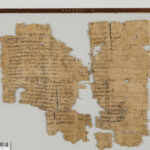| Artefact ID | 514 |
| TM ID | TM 64476 |
| Findspot (DEChriM ID) | - () | Class | Textual |
| Material | Papyrus |
| Writing medium | Sheet/roll |
| Text content | Subliterary |
| Language | Greek |
| Description | P.Amh. I 2 Three fragments (approx. 26.4 x 31.3 cm) containing an acrostic hymn. The verso remains blank. The text is arranged in 25 lines. Of these, all but the last consist of three parts which are metrically equivalent, and whose first letter represents a specific letter in the alphabet (e.g., the three parts of l. 1 begin with an alpha, the three parts of l. 2 begin with a beta, etc.). A dicolon separates part 1 from parts 2 and 3. The acrostic is metrical, and the three parts of the verse adhere to a dactylic schema with a final paroxytone, i.e. with an accented (with the exeption θεοῦ of part 1 in l. 10) penultimate syllable. The system seems to be partly tonal, partly quantitative, and the metre is affected by the variable determination of the length of the syllables and their accentuated form, see ed. pr. The hand is careful and cursive. The text contains several corrections, punctuation in the form of dicola as well as lexical indicators such as diaereses and apostrophes. The text also contains several nomina sacra. On the basis of the quality of the errors and omissions (as well as some Epic forms, see e.g. l. 3 and 8), the ed. pr. suggests that this was a copy removed only once or twice from the original manuscript. E. Preuschen suggests that the original hymn originates in the 2nd c.; see Preuschen 1901: 80. The final line does not adhere to the acrostic format: it is shorter (consisting of 2 parts compared to the 3 parts of lines 1-24) and does not highlight a letter of the alphabet. The content of this final line concerns itself with the topic of death. As a comparanda of this form of acrostic, the ed. pr. gives Ad Virgines Exhort. (Billius II: 299) by Gregory Nazianzen. |
| Selection criteria | Subliterary genre (Liturgical), Nomina sacra |
| Date from | 300 |
| Date to | 399 |
| Dating criteria | Palaeography. The ed. pr. places the hand (careful and cursive) in the first half of the 4th c. |
| Absolute/relative date | Relative date |
| Archaeological context | Provenance is uncertain. The fragment was purchased by J. Pierpont Morgan (1837-1913) in 1912. |
| Accession number | New York, Pierpont Morgan Library Dept. of Medieval and Renaissance Manuscripts. Manuscript Amh. Gr. Pap. 2. (previously part of a private collection in Norfolk). |
ARTEFACT IDENTIFIERS
Editio princeps:
∙ Grenfell, Bernard P. and Arthur S. Hund, eds. 1900. The Amherst Papyri, Being an Account of the Greek Papyri in the Collection of the Right Hon. Lord Amherst of Hackney, F.S.A. at Didlington Hall, Norfolk. London, no. 2 and plate no. 2.
Additional bibliography:
∙ Geerard, Maurits. 1983. Clavis Patrum Graecorum. Vol. 1: Patres Antenicaeni. Turnhout: Brepols, no. 1359 descr.
∙ Heitsch, Ernst. 1963. Die griechischen Dichterfragmente der römischen Kaiserzeit, gesammelt und herausgegeben. 2. edition. Göttingen. XLV 4 161.
∙ Marcus, Ralph. 1947. "Alphabetic Acrostics in the Hellenistic and Roman Periods". Journal of Near Eastern Studies 6 (2). 109-115.
∙ Preuschen, E. 1901. "Ein altchristlicher Hymnus". Zeitschrift Neutest. Wiss. 2. 73-80.
∙ van Haelst, Joseph. 1976. Catalogue des papyrus littéraires juifs et chrétiens. Paris, no. 844 descr.
∙ Vinogradov, Andrei Yu. 2005. "Tri krestalnikh gimna s alfabitnim akrostikhom = Three Baptismal Hymns with Alphabetical Acrostic". Journal of Ancient History 3 (254). 97-114.
∙ Wessely, C. 1907. Les plus anciens monuments du christianisme écrits sur papyrus. Vol. 1. Paris. 205-209.
∙ Wolbergs, Thielko. 1971. Griechische religiöse Gedichte der ersten nachchristlichen Jahrhunderte: Psalmen und Hymnen. Meisenheim am Glan, Hain. 16-20.


 Json data
Json data





